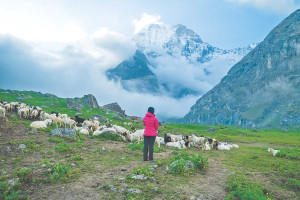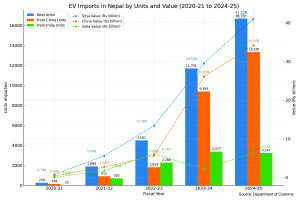Money
Nepal is a content creation paradise
Toshiyuki Ishii, president and CEO of Canon Singapore Pte Ltd. talks about Canon’s presence in Nepal, the future of imaging, and how camera companies adapt in the smart-phone era.
Post Report
Toshiyuki (Tiger) Ishii, president and CEO of Canon Singapore Pte Ltd., oversees Canon’s operations in 23 countries across South and Southeast Asia. With more than three decades of experience across global markets, including China, Canada, the US, Europe, and Hong Kong, Ishii recently visited Nepal. The Post caught up with him to talk about Canon’s presence in Nepal, the future of imaging, and how camera companies adapt in the smartphone era. Excerpts:
What brings you here after so many years?
It has been over 25 years since I last visited Nepal, and I’m very pleased to be back. The primary goal of this trip is to strengthen Canon’s relationship with our local distributor, explore new business opportunities, and support the growth of our business in Nepal. I see great potential here, especially in photography and printing. By working closely with our partners, we aim to enhance our brand further and bring more value to Nepali customers.
Canon has had a strong presence in Nepal through Primax International since 1992. How would you assess the Nepali market?
Every market is unique and vital to Canon, and Nepal is no exception. This country is incredibly rich in natural beauty, with the world’s highest peak, vibrant national parks, and unique wildlife like the one-horned rhino and the Royal Bengal tiger. Nepal is culturally rich, with its festivals and jatras drawing attention from around the globe. It truly is a content creation paradise. Over the past decade, our collaboration with Primax International has helped Canon capture over 50 percent of the market share here. We've focused on developing a strong photo culture and delivering high-quality products and services to all kinds of creators.
What are some of Canon’s long-term goals in Nepal?
Canon is committed to building strong communities of photographers and content creators here. Through our partnership with Primax, we conduct workshops and photo walks and offer after-sales services through a factory-authorised service centre and a dedicated Canon brand shop. Our long-term vision is for Canon to be a top-of-mind brand for professionals and content creators at every level. We aim to understand their evolving needs and continue supporting them with the right tools and platforms.
Looking at the global market, which content creation segment is Canon focusing on the most?
Globally, we’ve seen a surge in content creation, primarily driven by the expansion of social media. Short-form video content, in particular, is an area where we see tremendous growth potential. In Asia, wedding photography and videography remain high-priority segments. These align closely with trends in Nepal, where the demand for high-quality wedding documentation and social media content is growing rapidly.
Canon is known for its imaging innovations. How do you see AI and video technology shaping the future of your products?
We're investing heavily in next-generation technologies. Our latest mirrorless systems feature cutting-edge deep learning for subject recognition and autofocus precision. This allows the camera to instantly identify and track subjects and actions with high accuracy, enhancing both photo and video capture. Combined with our latest VCM (Voice Coil Motor) lens technology, our EOS R system enables creators to produce professional-grade content with greater detail, colour accuracy, and creative control.
Are there any specific product launches that you’re excited about?
Yes, we’re excited about several recent and upcoming products. Our new EOS R50 V and PowerShot V10 are designed specifically for videographers and content creators. These cameras are compact and powerful and offer great video capabilities along with excellent still photo performance. If you try them, you’ll notice how intuitive and accessible they are—ideal for today’s creators who need to produce high-quality content quickly and easily.
Smartphones have revolutionised photography by putting powerful cameras in everyone’s pocket. How has Canon adapted to this shift?
Smartphones have indeed made photography accessible to the masses, and they’ve raised people’s expectations for image quality. Interestingly, this has created a greater appreciation for more advanced imaging tools. Digital cameras still offer several advantages: superior low-light performance, eye-detection autofocus, face tracking, and lens versatility, to name a few. These benefits become especially valuable in genres like wildlife, sports, portrait, wedding, and lifestyle photography. We also see a clear trend in content creation shifting toward hybrid and short-form media, especially on platforms like Instagram and TikTok. Canon addresses this with a whole ecosystem—compact and digital interchangeable lens cameras, a wide range of lenses, and even specialised optics for virtual reality.
Have you seen a spike in camera sales driven by the rise of social media platforms?
Absolutely. Social media is a major driving force behind increased camera interest, especially among younger audiences like Gen Z. We’ve noticed a renewed enthusiasm for compact digital cameras that offer quality and simplicity. Canon has responded to this with products like the PowerShot V10 and EOS R50, which are optimised for content creation and sharing. These models are designed to be robust and user-friendly, and the feedback has been very encouraging.
Finally, what message would you like to share with content creators in Nepal?
Nepal has an incredible pool of talent and an inspiring cultural and natural environment. To all creators here: whether you’re a professional photographer, a filmmaker, or someone exploring your passion through social media, Canon supports your journey. We are committed to empowering creators with the right tools, education, and opportunities to tell their stories in the most powerful ways possible.




 21.47°C Kathmandu
21.47°C Kathmandu
















